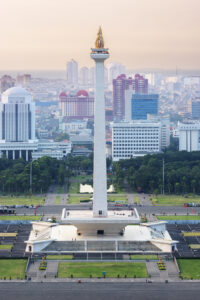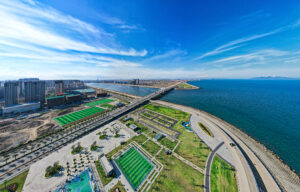Why Jakarta is the fastest-sinking city?
Discover the reasons behind Jakarta’s sinking crisis and explore potential solutions to mitigate the alarming rate of subsidence and rising sea levels. Uncover the natural and human factors contributing to this phenomenon and learn how the government and authorities can take action to secure the city’s future. Join us as we unravel Jakarta’s sinking crisis and seek sustainable solutions for this pressing issue.

Jakarta has a population of over 15 million people.
Jakarta is considered to be consuming too much groundwater.
Jakarta, the bustling capital of Indonesia, is facing an unprecedented crisis – it is sinking at an alarming rate. This once-vibrant city, home to millions of people, is experiencing land subsidence and rising sea levels, leading to devastating consequences. In this blog post, we will delve into the reasons behind Jakarta’s sinking problem, exploring both natural and human factors that contribute to this phenomenon. Furthermore, we will discuss potential solutions that the government and authorities can implement to minimize the rate of sinking and mitigate the long-term impact on the city and its inhabitants.
I. Understanding Jakarta’s Sinking Crisis
- Geographical Factors:
- Location: Jakarta is situated in a coastal area with soft, sedimentary soil that is prone to subsidence.
- Groundwater Extraction: Excessive pumping of groundwater for domestic and industrial purposes has resulted in the compaction of the underlying soil layers, leading to subsidence.
- Rapid Urbanization and Overpopulation:
- Population Growth: Jakarta has experienced rapid population growth, leading to increased demand for housing, infrastructure, and resources.
- Land Conversion: To accommodate the growing population, vast areas of marshlands and wetlands have been converted into residential and commercial spaces, disrupting natural drainage systems and exacerbating subsidence.
II. Impact of Rising Sea Levels
- Climate Change:
- Global Warming: As a result of climate change, sea levels are rising at an accelerated pace, posing a significant threat to coastal cities like Jakarta.
- Increased Flooding: Rising sea levels contribute to more frequent and severe coastal flooding, exacerbating the city’s vulnerability to sinking.
- Increased Risk of Natural Disasters:
- Storm Surges: Higher sea levels increase the risk of storm surges, which can cause extensive damage to coastal areas and exacerbate subsidence.
- Earthquakes: Jakarta is situated in a seismically active region, and earthquakes can further worsen the sinking problem by causing ground shaking and soil liquefaction.
III. Potential Solutions for Jakarta’s Sinking Crisis
- Groundwater Management:
- Reduction in Groundwater Extraction: Implement strict regulations and incentivize the reduction of groundwater pumping, encouraging alternative water sources such as rainwater harvesting and wastewater recycling.
- Improved Water Infrastructure: Invest in efficient water supply systems, leak detection technologies, and water conservation programs to reduce reliance on groundwater.
- Coastal Defense and Land Reclamation:
- Construction of Sea Walls and Barrages: Develop robust coastal defence systems, including sea walls and barrages, to protect the city from rising sea levels and storm surges.
- Land Reclamation Projects: Reclaim land from the sea by building artificial islands and coastal embankments, providing additional space for urban development while minimizing pressure on existing land.
- Urban Planning and Resettlement:
- Sustainable Urban Development: Encourage compact and sustainable urban planning practices that prioritize green spaces, water-sensitive designs, and improved drainage systems.
- Resettlement of Vulnerable Areas: Identify high-risk zones and relocate affected communities to safer areas, providing adequate infrastructure and services to ensure a smooth transition.
- Awareness and Education:
- Public Engagement: Raise awareness among the general public about the sinking issue and its underlying causes, encouraging individuals to adopt sustainable practices and reduce their environmental footprint.
- Education and Research: Invest in scientific research, data collection, and monitoring systems to better understand the sinking phenomenon and develop targeted solutions.
The following are the reasons for the sinking of the Jakarta:
The excessive exploitation of groundwater, according to some, is a key contributing factor to the sinking of Jakarta. Jakarta’s water levels are dangerously low for drinking, bathing, and other daily activities.
Piped water is also not accessible in most regions, so residents must rely on pumping water from aquifers that are hundreds of feet below ground level. This is the reason why the ground dips or declines in some places. When the land is deflated, it seems to be resting on a balloon.
Jakarta is booming in IT Sector, resulting in urbanisation
In addition, there is socioeconomic development, which includes urbanisation and population expansion and a rise in the demand for groundwater and a corresponding increase in dependency on it. Flooding dangers are enhanced, infrastructure is damaged, and lives are lost as a result of this, in the end.
The second concern is climate change, which implies that sea levels will rise more quickly during severe weather events, forcing embankments to collapse and flooding to occur.
Jakarta is Industrial hub of Indonesia
There was no proper focus done in past to diversify the industries to other cities which is resulting in excessing population in Jakarta.
Poor city planning is also one of the primary factors for the city of Jakarta to sink.
The effects of subsidence have become worse as a result of the economic growth. It is more difficult to mitigate the effects of subsidence caused by groundwater extraction when populations are growing in low-lying regions. According to official figures, Indonesia’s population has increased by 35% since 1990.
The Root Causes of Generalized Urban Flooding
Climate Change (Climate Change): This is one of the primary factors contributing to the rise in sea levels and the increase in rainfall, which results in flooding.
Because concrete is used in the building of roadways, there is less seepage of groundwater and flooding in urban areas.
Urbanisation has increased population, which has raised resource demand, and climate change will add additional factors to the equation. Groundwater would be used to an even greater extent due to this.
Urban Floods
Planting mangroves in these coastal plains regions may help reduce the severity of floods in the future. Mangroves are claimed to bind the earth together and keep water in the ground where they are planted if properly managed.
An extensive network of prop roots gives the impression that the trees are standing on stilts over the water. Furthermore, global warming must be managed in order to prevent climate change from occurring.
This would result in weather fluctuations and rainfall that could be regulated. According to the World Bank, better city design, which avoids concentrations near natural resources, might also be one of the answers to controlled urban flooding.
What is causing Jakarta to steadily sink?
According to the study’s findings, the primary source of the issue is the excessive use of groundwater by homeowners as a consequence of significant development. Residents in Jakarta rely on their own wells to get fresh water from the groundwater supply system.
What causes Jakarta to flood so frequently?
The misuse of groundwater in Jakarta is the primary cause of land subsidence. At the same time, owing to a lack of watershed lands and overpopulation of the capital, the groundwater’s ability to recharge has been reduced significantly.
Which city is dropping the most quickly?
As the world’s fastest sinking city (sinking by 6.7 inches per year), Jakarta is the fastest sinking metropolis globally. According to analysts, North Jakarta will be flooded to a depth of 95 per cent by the year 2050. The area has plummeted 2.5 meters below sea level in only ten years, with about half of the city now below sea level.
Why is Jakarta expanding at such a rapid pace?
Since 1940, the city of Jakarta has seen significant growth in population. An important factor in the rise in population may be immigration, which has changed Jakarta into one of the world’s most populous metropolitan agglomerations.
What portion of Jakarta is now underwater?
By the end of 2050, it is projected that North Jakarta will be submerged to a depth of up to 95 per cent. North Jakarta has already fallen 2.5 meters in the last ten years and is expected to continue sinking by about 25 centimetres each year in different regions of the city. As a result, this is more than double the worldwide average for coastal megacities throughout the globe.
Conclusion
Jakarta’s sinking crisis poses a significant challenge for the city and its inhabitants. By understanding the underlying causes, such as geographical factors, rapid urbanization, and rising sea levels, we can identify potential solutions to mitigate the sinking rate. Groundwater management, coastal defense, sustainable urban planning, and public engagement are crucial elements in addressing this complex issue. It is essential for the government, authorities, and communities to work collaboratively and implement proactive measures to secure Jakarta’s future, ensuring the city remains resilient and sustainable for generations to come.






